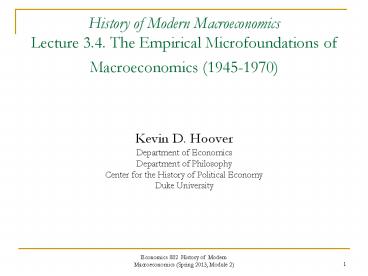History of Modern Macroeconomics Lecture 3.4. The Empirical Microfoundations of Macroeconomics (1945-1970) Kevin D. Hoover Department of Economics Department of Philosophy Center for the History of Political Economy Duke University - PowerPoint PPT Presentation
Title:
History of Modern Macroeconomics Lecture 3.4. The Empirical Microfoundations of Macroeconomics (1945-1970) Kevin D. Hoover Department of Economics Department of Philosophy Center for the History of Political Economy Duke University
Description:
History of Modern Macroeconomics Lecture 3.4. The Empirical Microfoundations of Macroeconomics (1945-1970) Kevin D. Hoover Department of Economics – PowerPoint PPT presentation
Number of Views:431
Avg rating:3.0/5.0
Title: History of Modern Macroeconomics Lecture 3.4. The Empirical Microfoundations of Macroeconomics (1945-1970) Kevin D. Hoover Department of Economics Department of Philosophy Center for the History of Political Economy Duke University
1
History of Modern MacroeconomicsLecture 3.4. The
Empirical Microfoundations of Macroeconomics
(1945-1970) Kevin D. HooverDepartment of
EconomicsDepartment of PhilosophyCenter for the
History of Political EconomyDuke University
2
Two Macroeconomic Traditions of the 1930s 1
- Frisch/Tinbergen
- micro/macro distinction
- macro dominates micro
- problem of aggregation ignored
- supported econometrics
- engineering attitude
- socialist/central planner
3
Two Macroeconomic Traditions of the 1930s 2
- Keynes
- micro/macro distinction (not in those words)
- micro at root macro emergent
- problem of aggregation does not arise
- hostile to econometrics
- medical attitude
- AsideIf economists could manage to get
themselves thought of as humble, competent people
on a level with dentists, that would be
splendid. John Maynard Keynes (1931) - liberal/saving markets from their own
fallabilities
4
Wartime Planning and Controls
5
Wartime Planners
Milton Friedman (1912-2006)
John Kenneth Galbraith (1908-2006)
6
Economists and the War
- The other thing that was so important in the
fifties and sixties was operations research.
The World War II generation brought a whole bunch
of smart guys, like Abraham Wald and Friedman,. .
. I mean everybody into Washington to work on the
war effort, and economists thought of all kinds
of great stuff . . . I guess thats what we
always claim. We invented the convoy system . .
. we basically won the war singlehandedly. - Robert E. Lucas, Jr.
7
Keynes Mostly Lost. What Survived
- Consilience of Keyness ontology with the
national income and product accounts - Interventionist attitude
- Neoclassical synthesis
- Already in Keynes classical is special case of
the general theory - Picked up by Klein (The Keynesian Revolution)
- Samuelson implicit in 1st edition of Economics
(1948) term coined in 3rd edition (1955)
8
The New Empirical Macroeconomics
- Walrasian
- general equilibrium
- individual optimization (microfoundations)
- IS-LM Keynesian
- Aggregation
- practice demands
- must be eliminable in theory
- work towards maximum disaggregation
Lawrence Klein (1920- )
9
IS-LM-AS Sets the Agenda for Macroeconmetric
Models
10
Hydraulic Keynesianism The Phillips Machine or
Moniac
11
Phillips Machine Schematic
12
Phillips Machine Details
13
Phillips Machine in Punch
14
IS-LM-AS Sets the Agenda for Macroeconmetric
Models
15
Microfoundations Transactions Demand for Money
(Baumol) 1
16
Microfoundations Transactions Demand for Money
(Baumol) 2
17
Microfoundations Transactions Demand for Money
(Baumol) 3
- Implications
- Income-elasticity of money demand ½
- Interest-elasticity of money demand ½
- Compare to the Traditional Quantity Equation
- Income-elasticity of money demand 1
- Interest-elasticity of money demand
undetermined (possibly zero)
18
Microfoundations of the Various Keynesian
Functions
- Transaction Demand for Money Baumol (1952)
- Speculative Demand for Money Tobin (1958)
- Consumption Function Duesenberry (1949)
Modigliani and Brumberg (1952) Friedman (1945
1955) - Investment Jorgensen (1966)
- Production Function (Franklin Fisher 1969)
- Labor Supply Lucas and Rapping (1969)
19
Kleins Modeling Agenda
- In contrast with the parsimonious view of
natural simplicity, I believe that economic life
is enormously complicated and that the successful
model will try to build in as much of the
complicated interrelationships as possible. That
is why I want to work with large econometric
models and a great deal of computer power.
Instead of the rule of parsimony, I prefer the
following rule the largest possible system that
can be managed and that can explain the main
economic magnitudes as well as the parsimonious
system is the better system to develop and use.
Klein 1992
20
An Opposing Current
- the focus should be on the analysis of parts of
the economy in the hope that we can find bits of
order here and there and gradually combine these
bits into a systematic picture of the whole
1951 - A hypothesis is important if it explains much
by little, that is, if it abstracts the common
and crucial elements from the mass of complex and
detailed circumstances surrounding the phenomena
to be explained and permits valid predictions on
the basis of them alone. Friedman 1953, p. 14 - We curtsy to Marshall, but we walk with Walras
1949
Milton Friedman (1912-2006)
21
Genealogy of Kleins Macroeconometric Models
22
Complexity of Kleins Models
Model Number of Equations
Klein Model I (1950) 6
Klein Model II (1950) 3
Klein Model III (1950) 12
Klein-Goldberger (1955) 25
Brookings-early (1959) about 200
Brookings-late (1972) about 400
23
Brookings Model (1965)
24
Phillips Machine Schematic
25
The IS-LM Core of a Large-scale Macroeconometric
Model
- Source Green et al. The IS-LM Cores of Three
Econometric Models, in Lawrence Klein (editor)
Comparative Performance of U.S. Econometric
Models, p. 104.
26
Computing Power as a Limitation on Economic
Modeling
Before World War II
After World War II
Burroughs Adding Machines in Veterans Bureau
Computing Section
Eniac The First American Digital Computer
27
- Thanks
- ??
- The End






























